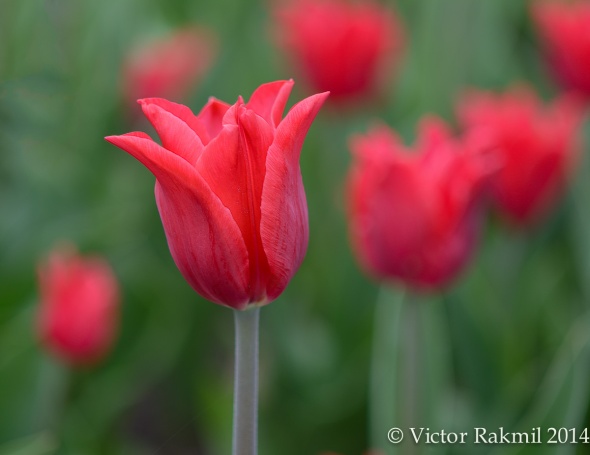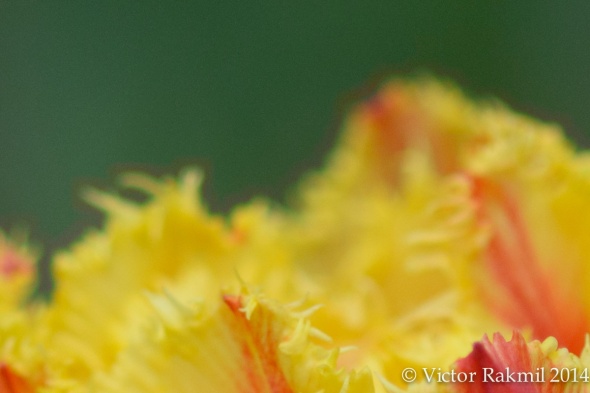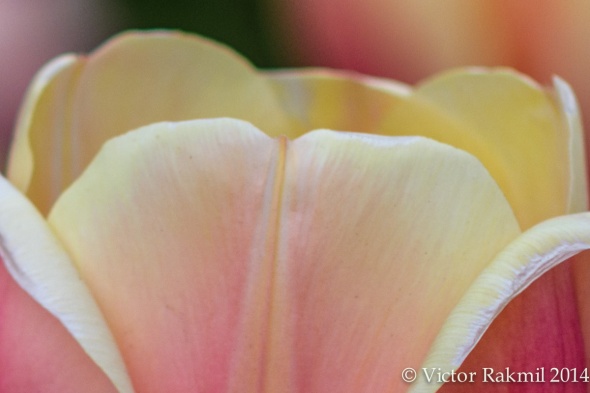Tulip Festival 3 (and a new Gallery and comments on fringing and halos)
 To view the gallery of these photographs please click on: Tulips
To view the gallery of these photographs please click on: Tulips
There are a lot of technical explanations you can read about chromatic aberration –CA- color fringing – green or purple fringing around the edges of a photograph and how to fix it in various software packages. Essentially CA is a result of how color and light are handled by the lens and it can happen with the most expensive of lenses. New coatings and in-camera software are reducing this phenomenon but it is unlikely to go away completely. Many software packages have tools to defeat CA and you can always paint/clone or heal it away. It’s a good idea to look out for it and fix it especially if you will make a larger version of your photograph.
Halos are very similar to CA, a sort of ghosting along the edges of some objects. This occurs with overdone sharpening and when some other post processing is taken too far. But we also get halos in nature because of light catching or passing through some of the floral backgrounds close to the edges of our subjects, like tulips planted close together. Painting this away in post-processing is one method; fading it, using the fixes for chromatic aberration may also help. In the two galleries of tulips that I have posted, I had to work on this in a few of the photographs and it took some effort to reduce the effect. This type of haloing is a natural phenomenon with vibrant coloured flowers and great light. It can be quite evident when the photograph is looked at closely. More than likely in postings on this blog it is invisible. It may not be so invisible in the SmugMug galleries given the higher resolution and larger size of the photographs. It’s worth looking closely at your photographs before publishing to the web or printing to ensure these kinds of issues, if serious, are reduced to near invisibility as they will catch the eye of your viewer.
One of the reasons I take so long to post my photos is the work I put into post processing; subtle though that processing may be, the object is to reduce technical problems and keep my audience’s eye on the subject. Two examples of CA and haloing (both are present) are below, enlarged and to a degree exaggerated so it will be evident on the web.



Beautiful
LikeLike
June 28, 2014 at 6:01 pm
Thanks.
LikeLike
June 28, 2014 at 6:02 pm
Lovely tulip gallery.
LikeLike
June 28, 2014 at 3:58 pm
Reducing chromatic aberration is one of my steps on importing to lightroom along with lens correction. I think it is one of the less talked about areas of editing. Very interesting to read a little bit more about it.
LikeLike
June 28, 2014 at 2:15 pm
Thanks. The auto controls do a basic job, but I do love the tools in Lightroom, the eye dropper for chromatic aberration is a real plus.
LikeLike
June 28, 2014 at 4:19 pm
I remember years ago I had CA on some power lines in an image. Photoshop CS2 wasn’t good with dealing with CA, the tools in lens cirrection weren’t that good. To fix the problem I had to use hue saturation adjustment and masking. A lot of work unlike now, although when I get some complex CA I do have to go back to photoshop.
LikeLike
June 28, 2014 at 11:58 pm
While I have found older lenses do better, Nikon says older lenses designed for film should not do as well. Go figure.
LikeLike
June 29, 2014 at 6:02 am
I just realized my magnolia has these aborations! I opened it up in photoshop and then selected my camera raw filter. I adjusted it there and it worked! I’ll replace my existing photo with the new one. Thank you so much! For some reason I only adjusted these if I was working in an HDR program like Photomatix.
LikeLike
June 28, 2014 at 1:17 pm
Your magnolia is great. I think the biggest challenge with flowers like that is how much detail to enhance, I am always having to walk it back…
LikeLike
June 28, 2014 at 4:18 pm
Yes I agree. The first one i circled on G+ (my testing ground) did not look good and didn’t get much attention. The next day I viewed it and thought EWWWE! So I dialed it way back and added some dimension and zoomed in on it when I noticed those chromatic aborations. Easily gotten rid of and I really appreciate this technical advice.
LikeLike
June 28, 2014 at 6:18 pm
Very informative. My recent flower is probably a flop! I’m going to have a looksie….
LikeLike
June 28, 2014 at 1:05 pm
Well articulated! I’ve encountered this as well and it is a bit tedious, but worthwile, to remove.
LikeLike
June 28, 2014 at 11:23 am
Thanks. Not the most fun topic but I could not ignore it.
LikeLike
June 28, 2014 at 4:16 pm
Beautiful gallery! Good topic, too.
LikeLike
June 28, 2014 at 8:38 am
Thanks. I worried it was a bit technical.
LikeLike
June 28, 2014 at 4:16 pm
Beautiful photos!
LikeLike
June 28, 2014 at 7:42 am
Much appreciated. Thank you.
LikeLike
June 28, 2014 at 4:15 pm
Very interesting
LikeLike
June 28, 2014 at 6:38 am
Thanks, I was hoping people would find it interesting.
LikeLike
June 28, 2014 at 4:15 pm
in fact I never noticed the effect you are describing until I read your article yesterday, then I went back to some of my photos in my files and it’s there on plenty of those ……. although I do not always comment I find all your posts very informative
LikeLike
June 28, 2014 at 4:45 pm
Thanks I appreciate that. I also hope I have not created a lot of work for you…
LikeLike
June 28, 2014 at 4:47 pm
As always this is very helpful. Thanks Victor 🙂
LikeLike
June 28, 2014 at 1:40 am
Glad to hear that!
LikeLike
June 28, 2014 at 5:09 am